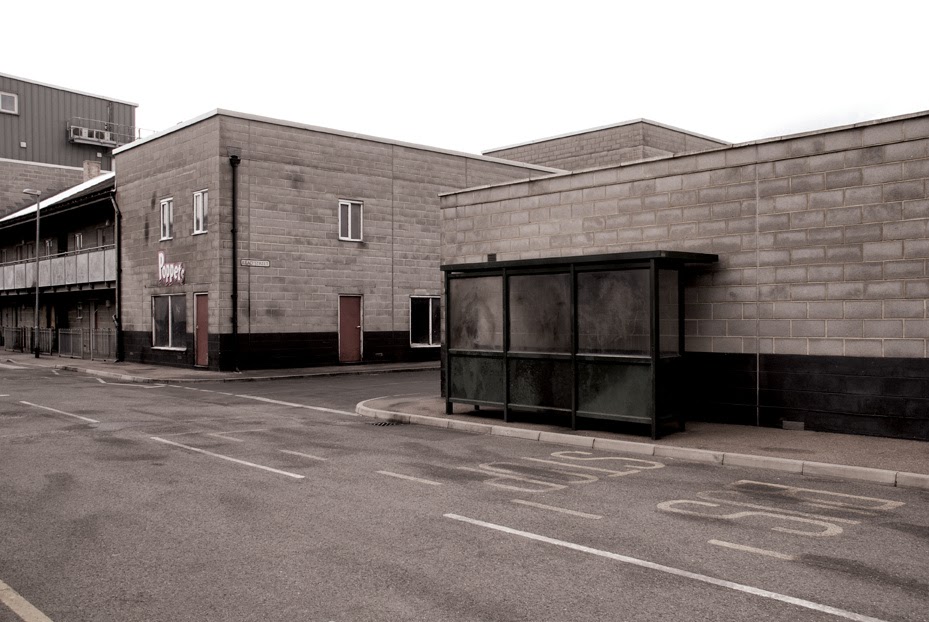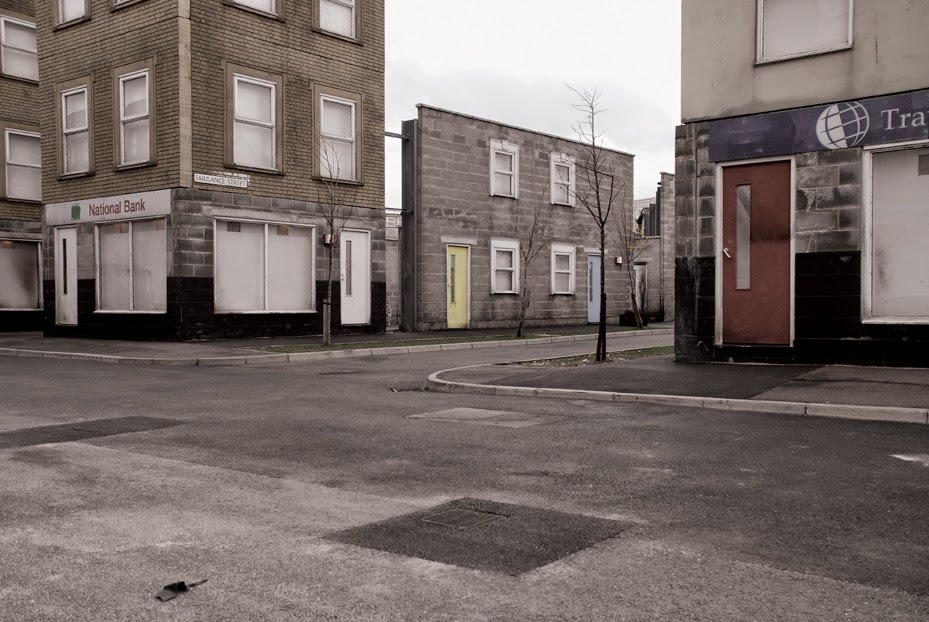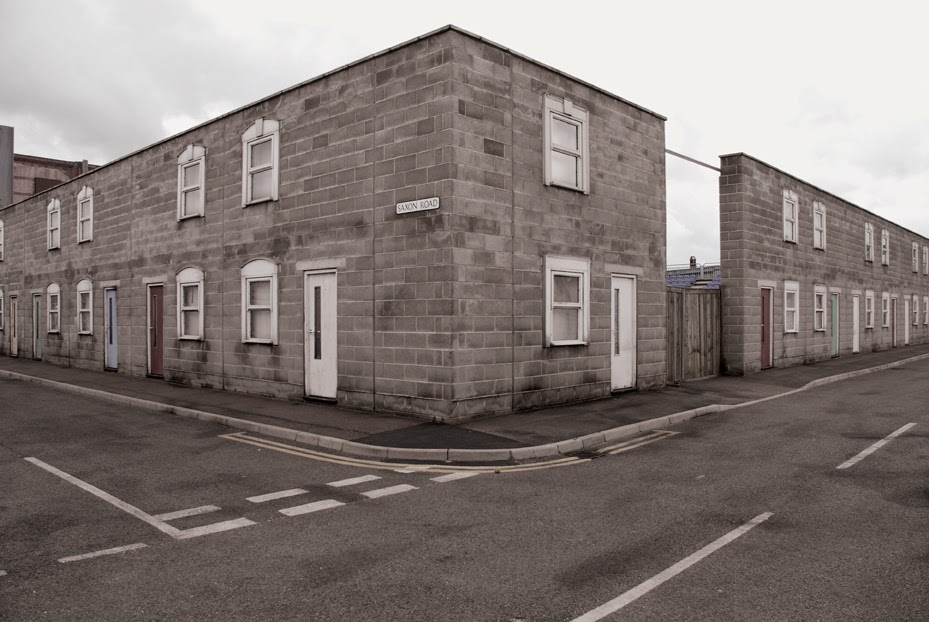 [Image: From Gravesend—The Death of Community by Chris Clarke].
[Image: From Gravesend—The Death of Community by Chris Clarke].
Gravesend is a suburb east of London, hosting on its own eastern edge something of a secondary suburb: a mysterious town on the edge of town that turns out not to be a town at all.
It is a simulated English village built in 2003 by the Metropolitan Police working with Equion Facilities Management and a firm called Advanced Interactive Systems (AIS).
The barren streets and hollow buildings of this militarized non-place were designed for use as an immersive staging ground for police-training exercises, fighting staged riots, burglaries, bank robberies, and other crimes.
 [Image: From Gravesend—The Death of Community by Chris Clarke].
[Image: From Gravesend—The Death of Community by Chris Clarke].
Facades with no buildings behind them line the empty streets; in some cases, it is only through the aerial views afforded by a service like Google Maps that this reality is made clear.
Imitation bus stops, make-believe banks, and an oddly whimsical Pizzaland—like an end-times chain restaurant from Shaun of the Dead—sustain the illusion on the ground.
 [Image: From Gravesend—The Death of Community by Chris Clarke].
[Image: From Gravesend—The Death of Community by Chris Clarke].
Somewhat incongruously, an airplane fuselage also now rests beside a chainlink fence near the roadway, giving officers an opportunity to prepare for airplane hijackings.
There are even empty Tube carriages parked outside town for improvisatory police raids.
 [Image: From Gravesend—The Death of Community by Chris Clarke].
[Image: From Gravesend—The Death of Community by Chris Clarke].
According to AIS, their consultant-designers kitted out the site’s “live-fire ranges with internal ballistic and anti-ricochet finishes, simulation and targetry equipment, and range sound systems,” a complete multimedia package that would soon also include HD video projectors and even “laser-based 3D virtual training environments.”
Architectural simulations embedded with high-tech, upgradeable media technology thus supply the necessary level of detail for repeating crimes, on demand, like strange social rituals.
 [Image: From Gravesend—The Death of Community by Chris Clarke].
[Image: From Gravesend—The Death of Community by Chris Clarke].
The photos seen here were all take by designer and photographer Chris Clarke, whose Flickr set of the series, including a dozen or so further images, is worth a look.
 [Image: From Gravesend—The Death of Community by Chris Clarke].
[Image: From Gravesend—The Death of Community by Chris Clarke].
For Clarke, the “facsimile” urbanism of this site at the end of Gravesend is actually something of “a warning—a prophecy of society’s potential to alienate itself from itself.” He suggests that these surreal scenes threaten to become indistinguishable from everyday life, our cities and streets stripped down to the civic minimum, used as nothing more than bleak stomping grounds for futuristic security forces armed with military-grade tools.
“We have estates, parks, nightclubs, tube stations,” Clarke writes, “but is the community missing from Gravesend significantly more present in our inhabited cities and towns?” His own answer remains unspoken but obvious.

 [Images: From Gravesend—The Death of Community by Chris Clarke].
[Images: From Gravesend—The Death of Community by Chris Clarke].
Writing about this same site back in 2008, Brian Finoki of Subtopia called it a “new theater of the absurd.”
It is, he wrote, “a city standing on the planet for one purpose: to be rioted, hijacked, trashed, held hostage, sacked, and overrun by thousands of chaotic scenarios, only so that it can be reclaimed, retaken, re-propped in circuitous loops of more dazzling proto-militant exercise, stormed by a thousand coordinated boots for eternity, targeted by hundreds of synchronized crosshairs of both lethal and non-lethal weapons.”
 [Image: From Gravesend—The Death of Community by Chris Clarke].
[Image: From Gravesend—The Death of Community by Chris Clarke].
Check out more photos at Chris Clarke’s Flickr page.
(Related: In the Box: A Tour Through the Simulated Battlefields of the U.S. National Training Center).

Apropos of nothing, Gravesend appears in the novel "The Bone Clocks" by David Mitchell, which just came out. This novel would appeal to the readers of Bldgblog, I think. (No affiliation w/ the author or any booksellers.)
ed
Another good photoset from the Guardian in June includes "riot" photos:
http://www.theguardian.com/uk-news/gallery/2014/jun/24/police-riot-training-in-fake-kent-town-in-pictures
More riot photos from the Telegraph – obviously with Prince Charles visit angle, because Telegraph:
http://www.telegraph.co.uk/news/picturegalleries/royalty/5487689/Prince-Charles-observes-riot-police-in-action.html?image=7
Thanks, Ed! I haven't gotten around to that one yet, but it's on my list.
James, those are great—the equestrian-centric shots, showing the rear-ends of horses just barely visible clomping up the simulated street toward battle, are particularly (and literally) fantastic.
Weird and fascinating spot indeed. It talks much and loud about our present and future.
As a byproduct of the construction bubble/financial crisis in Spain have appeared empty urban places (as for instance Valdeluz, a brand new city 80 km far from Madrid, planned for 30000 people and inhabited by barely 2000 now), that could be in the future scenarios of this kind, because they were born dead and nobody knows what to do with them. Who knows.